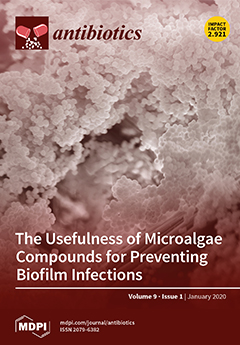Conjugation of penicillin G (
PenH) with silver(I) ions forms a new CoMeD (conjugate of metal with a drug) with formula [Ag(pen)(CH
3OH)]
2 (
PenAg).
PenAg was characterized by a plethora of physical and spectroscopic techniques, which include in the solid state m.p.; elemental analysis; X-ray fluorescence (XRF) spectroscopy; scanning electron microscopy (SEM); energy-dispersive X-ray spectroscopy (EDX); FT-IR; and in solution: attenuated total reflection spectroscopy (FT-IR-ATR), UV–Vis,
1H NMR, and atomic absorption (AA). The structure of
PenAg was determined by NMR spectroscopy. Silver(I) ions coordinate to the carboxylic group of
PenH, while secondary intra-molecular interactions are developed through (i) the nitrogen atom of the amide group in MeOD-d
4 or (ii) the sulfur atom in the thietane ring in deuterated dimethyl sulfoxide DMSO-
d6. The antibacterial activities of
PenAg and the sodium salt of penicillin (
PenNa) (the formulation which is clinically used) against Gram positive (
Staphylococcus epidermidis (
S. epidermidis) and
Staphylococcus aureus (
S. aureus)) and Gram negative (
Pseudomonas aeruginosa (
P. aeuroginosa PAO1)) bacteria were evaluated by the means of minimum inhibitory concentration (MIC), minimum bactericidal concentration (MBC), and inhibition zone (IZ).
PenAg inhibits the growth of the Gram negative bacterial strain
P. aeuroginosa with a MIC value of 23.00 ± 2.29 μM, in contrast to
PenNa, which shows no such activity (>2 mM). The corresponding antimicrobial activities of
PenAg against the Gram positive bacteria
S. epidermidis and
S. aureus are even better than those of
PenNa. Moreover,
PenAg exhibits no in vivo toxicity against
Artemia salina at concentration up to 300 μΜ. The wide therapeutic window and the low toxicity, make
PenAg a possible candidate for the development of a new antibiotic.
Full article






